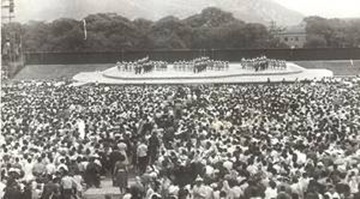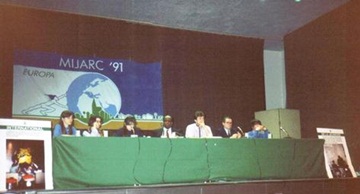Europe
MIJARC Europe history
 The birth...
The birth...
Already before the World War II the Catholic rural youth movements existed, but only after the World War II they felt the necessity to get in contact with rural youth coming from other countries and to build up an international understanding. Building up a world with social and economic justice was one reason why the movements of Flanders - Wallonia (Belgium), France, Netherlands, Luxembourg, Italy, Germany, Portugal, Switzerland and Austria came together and established an international Catholic movement for rural and agricultural youth during the 50’s. And from the beginning MIJARC established contacts also with movements in other continents which led to the affiliation of movements in Canada, Latin-America, Africa and Asia.
 60’s
60’s
At the beginning of the 60s, because of the events that occur in Europe, after the creation of the European Economic Community in 1957, MIJARC Europe focuses its work on the organisation of reflection sessions about the market unification which takes place in an unequal and alarming way between the countries, about the migration policies and a criticism about the European economic policy that does not respect the rights of the small farmers.
In order to give special attention to the dynamic of Catholic rural youth movements Emile Perrot was hired as the first European secretary. The Coordination of the European movements organised seminars and events like the European Festival in Stuttgart in August 1965 gathering around 20,000 people and receiving a radio message from the Pope Paul VI.
80's
In the 80s MIJARC Europe counted with a staff of four people in the European Office who organised intercultural training sessions around the topics: Europe, GMOs, women in rural areas, Christian identity and international solidarity. Eight national movements from Spain, Germany, Portugal, Austria, Netherlands, Belgium, France and Germany constantly collaborated in the network of MIJARC. The main support for the activities was coming from the grants of the European Youth Foundation and DG Agriculture of the European Commission.
 90’s
90’s
The 90s were a quite fluctuating period for MIJARC Europe in terms of prosperity, but with very important historical happenings in terms of structuring the organisation.
The beginning of the 90s was very active and productive:
- The first European General Assembly took place in 1991 in Paris;
- There were 14 member movements;
- The European Coordination was meeting twice a year;
- MIJARC Europe was active in the networks of CPE (Coordination Paysanne Européenne, now called ECVC - European Coordination La Via Campesina), Plataforma Rural and the European Youth Forum;
- In 1992 six seminars were organised and in 1993 three;
After the fall of the Berlin wall or the well-known “Iron Curtain”, contacts were established with groups and movements in Eastern Europe. Meetings took place in Budapest and due to the efforts made by the German, Austrian and French movements, a network was set up. With rural youth organisations in Poland, Hungary, Slovenia and Latvia, a special East-West working group was created and bilateral partnerships have been developed.
In 1994, consequence of funds reimbursements, MIJARC Europe’s image was discredited towards donors (DG Agriculture) and the financial situation obliged a decreasing in the secretariat staff.
Due to tense relations between MIJARC Europe and MIJARC world, which have started already in the 80s, MIJARC Europe moves its office and decides to get juridical autonomy from MIJARC world. In 1996 MIJARC Europe is officially registered in the Belgian chamber of commerce as independent non-profit organisation, which meant also the beginning of political autonomy. Nine member movements signed the registered articles of MIJARC Europe constitution.
With the critical situation MIJARC Europe is passing, almost no activities are taking place at European level and in 99 the last post of full-timer is extinct. The fundraising for MIJARC Europe is decentralised and done by the national movements (European Coordinators).
An Orientations General Assembly (OGA) organised in 1999 brings a new impulse to the movement, defining a strategic Action Plan for 3 years, restructuring the organisational functioning (creation of the European Team with 3 people as executive body with political responsibilities, implementation of OGA’s every 3 years) and creating 4 working groups: Spirituality, Rural Development (CERIL Project) & Agriculture, Youth Policies and International Development.
2000’s
 In 2001 MIJARC Europe moves for the actual office address.
In 2001 MIJARC Europe moves for the actual office address.
MIJARC Europe starts to slowly recover from its complicated situation. The contacts with Eastern European countries are re-established and the representation in the European networks becomes more active, namely towards the Council of Europe (having a representative in the Advisory Council) and the European Youth Forum.
From 2001 to 2003 MIJARC Europe engages in a project to help KIM Hungary creating a national structure to support rural youth but the results were not as effective as expected.
In the OGA in 2003 a new European Team is elected composed by 3 national full-timers which should provide ¼ of their time for MIJARC Europe affairs.
An administrative full-timer was also possible to hire, thanks to the French programme “Youth Employment”. Thanks to this conjuncture it was possible to start getting again European funds to support the functioning of MIJARC Europe (“Youth” Programme from the European Commission).
In 2005 MIJARC Europe engages in a pilot project, in partnership with Rural Youth Europe: “Change the Village, Challenge yourself” a study on youth participation. This project broadens the horizons of MIJARC Europe in several aspects.
In the OGA of 2005, three working groups are created: Agriculture, Glocal (Global and local economic) alternatives and “Change the Village” (for the project management). As the European Team performance is evaluated as very positive for the management of the organisation, it’s decided that the “European Coordination” should be “European Commission”, to work more in content and the European Team will have the responsibility for more political tasks.
At this time, there are 7 member movements, including Romania and Catalonia who don’t participate in MIJARC activities and the contacts get weaker. No news also from KIM Hungary. Yet, Plattelandsjongeren.nl (former APWJ) from Netherlands is re-affiliated in this GA; new contacts are established with the Austrian movement; a study visit in Bulgaria allows developing links with NALFAP that becomes affiliated in 2006; and contacts are strengthened with a Polish movement.
Investment is put on the communication strategy of MIJARC Europe: renewal of the website, creation of a flyer explaining what MIJARC Europe is, in 3 languages, and exhibition posters.
A wide spread campaign starts to be prepared in 2008: “You(th) can make the Europe of Tomorrow!”. The aim is to raise awareness of rural young people about the European Institutions functioning and the European Parliament Elections in 2009 and instigate rural youth to go voting. A 4-pages flyer is created with information and postcards to be sent to the candidate MEPs with MIJARC Europe proposals for Europe, translated in 8 languages.
In the OGA 2009 it is defined a new and very concrete Action Plan for the period 2009-2013 with several activities outlined:
 > A Summer Camp every year
> A Summer Camp every year
> A Seminar every year and a campaign related to the seminar of the previous year
> A training session every 2 years
> A European Coordination and a General Assembly every year and the next OGA in 4 years
> Efforts should be made by the European Team to keep good contact with its member movements and work on the enlargement
> A working group on Communications is established to propose strategies of improvement of MIJARC Europe communication
The former “European Commission” is renamed again “European Coordination” in the statutes of MIJARC Europe and YMDRAB (former NALFAP) is affiliated.
Since then there was a great increasing of participation by the Team members in external representation, networking with partners and participation in their activities (RYE, YFJ and ECVC), which allows to strengthen old and get new contacts (Austria, Romania, Armenia, Croatia, Malta,...)
In 2010 EiR Poland, who enjoyed a status of Observer member, becomes affiliated. Two staff members are hired.
In 2011 MTRC Romania and Plattelandsjongeren.nl are excluded from MIJARC Europe membership and KIM Hungary becomes affiliated, after re-establishment of contacts since 2009.
In parallel to its own history, MIJARC Europe also actively participates in MIJARC World’s own history and structure as it is considered one of its branches, together with MIJARC Africa, MIJARC Asia and MIJARC Latin America.